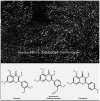The anti‑hepatitis B virus activity of sea buckthorn is attributed to quercetin, kaempferol and isorhamnetin
- PMID: 36185785
- PMCID: PMC9500493
- DOI: 10.3892/br.2022.1573
The anti‑hepatitis B virus activity of sea buckthorn is attributed to quercetin, kaempferol and isorhamnetin
Abstract
The present study assessed the in vitro anti-hepatitis B virus (HBV) effects of cold-adapted sea buckthorn (Hippophae rhamnoides). Sea buckthorn leaf ethanol extracts subjected to chloroform (SB-Chl), ethyl acetate (SB-Eac), n-butanol (SB-But) and aqueous (SB-Aqu) fractionation were first examined (MTT assay) for their toxic effects on HepG2 cells. While SB-Chl (IC50, 32.58 µg/ml) exhibited high cytotoxicity, SB-Eac, SB-But SB-Aqu were non-toxic at up to 150 µg/ml. High performance liquid chromatography analysis led to the identification of the anti-HBV active flavonols, quercetin (93.09 µg/g), kaempferol (44.19 µg/g) and isorhamnetin (138.75 µg/g) in the extract. The analysis of the anti-HBV effects of SB-Eac, SB-But and SB-Aqu (50 µg/ml, each) on HepG2.2.15 cells revealed the marked inhibition of HBsAg and HBeAg expression levels. At the concentration of 10 µg/ml, quercetin and kaempferol exerted potent inhibitory effects on HBsAg (60.5 and 62.3%, respectively) and HBeAg synthesis (64.4 and 60.2%, respectively), as compared to isorhamnetin (30.5 and 28.4%, respectively). The HBV-polymerase inhibitor drug, lamivudine (2 µM), inhibited HBsAg and HBeAg expression by 87.4 and 83.5%, respectively. The data were in good agreement with a previous in vitro and in silico molecular docking analysis performed by the authors where quercetin, kaempferol and lamivudine had formed stable complexes with HBV-polymerase binding-pocket amino acids. On the whole, to the best of our knowledge, the present study provides the first report of the anti-HBV therapeutic potential of sea buckthorn, attributed to quercetin, kaempferol and isorhamnetin.
Keywords: anti-hepatitis B virus; hepatitis B virus; isorhamnetin; kaempferol; quercetin; sea buckthorn.
Copyright © 2020, Spandidos Publications.
Conflict of interest statement
The authors declare that they have no competing interests.
Figures






References
-
- Li TSC. Taxonomy, natural distribution and botany. In: Sea Buckthorn (Hippophae rhamnoides L.): Production and Utilization. Li TSC and Beveridge T (eds). NRC Research Press, Ottawa, ON, pp 7-11, 2003.
LinkOut - more resources
Full Text Sources
